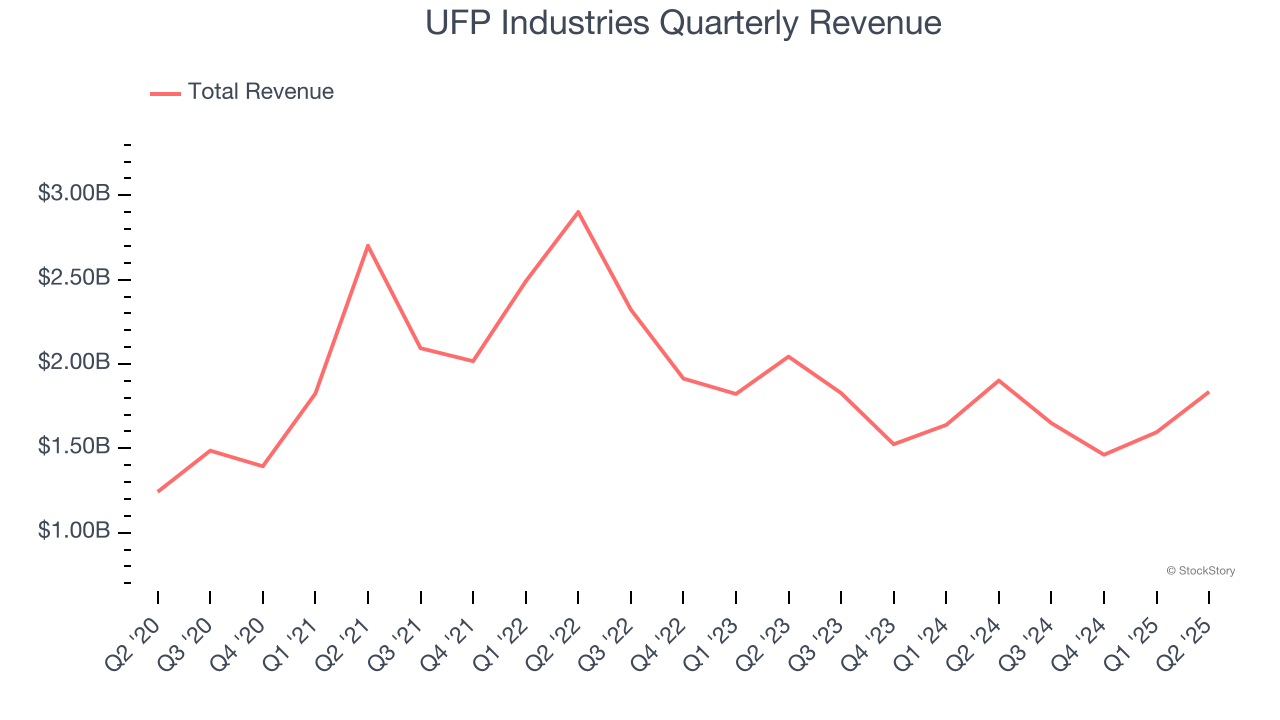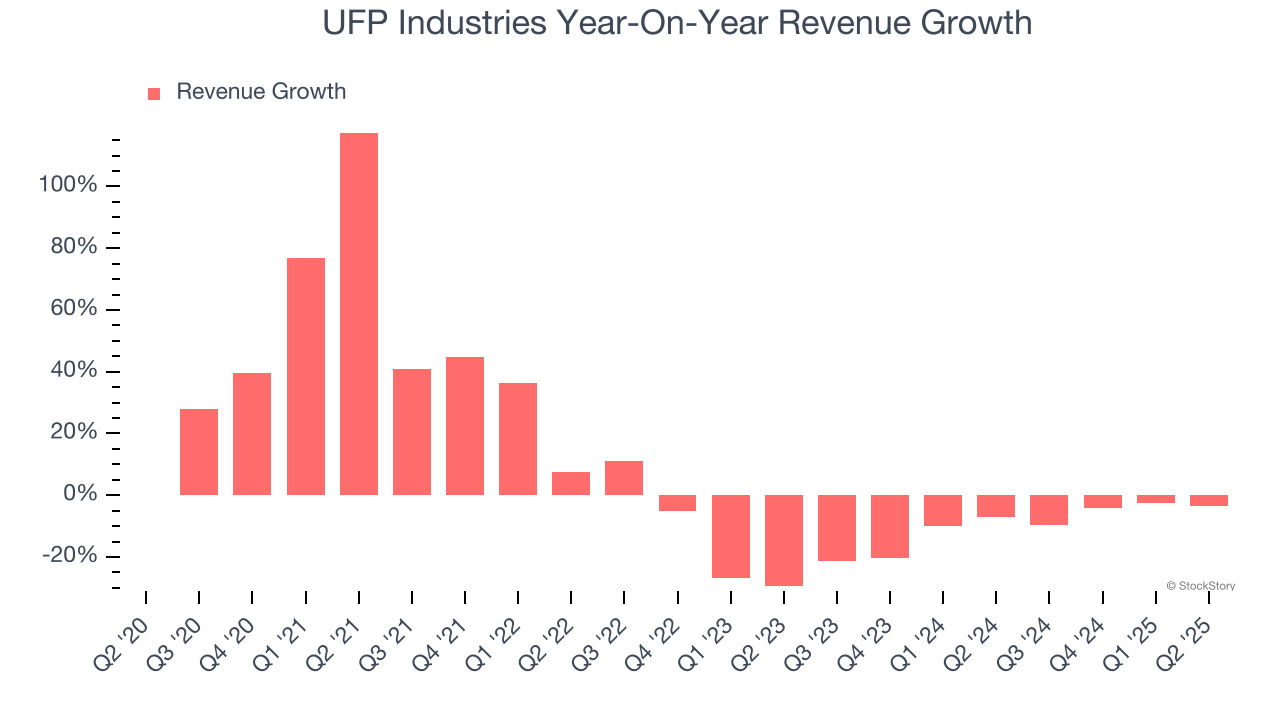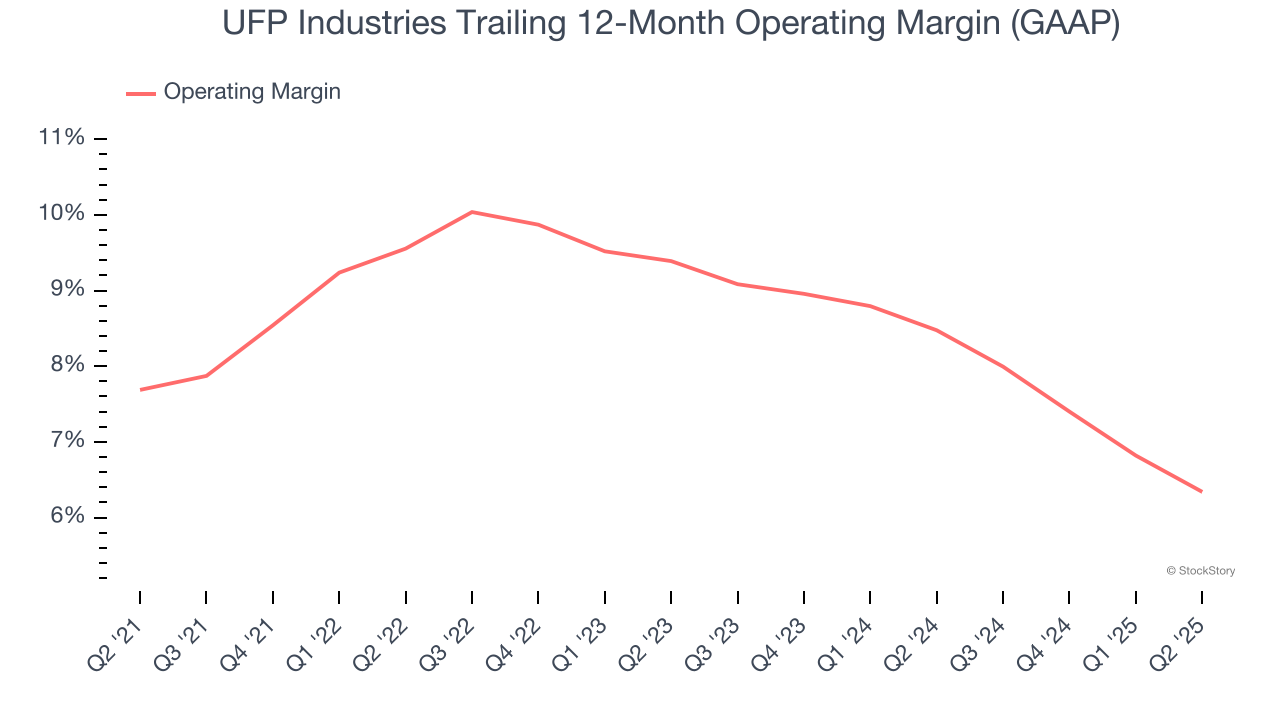
Building materials manufacturer UFP Industries (NASDAQ:UFPI) missed Wall Street’s revenue expectations in Q2 CY2025, with sales falling 3.5% year on year to $1.84 billion. Its GAAP profit of $1.70 per share was 8.7% below analysts’ consensus estimates.
Is now the time to buy UFP Industries? Find out by accessing our full research report, it’s free.
UFP Industries (UFPI) Q2 CY2025 Highlights:
- Revenue: $1.84 billion vs analyst estimates of $1.87 billion (3.5% year-on-year decline, 1.9% miss)
- EPS (GAAP): $1.70 vs analyst expectations of $1.86 (8.7% miss)
- Adjusted EBITDA: $174.1 million vs analyst estimates of $179.7 million (9.5% margin, 3.1% miss)
- Operating Margin: 6.7%, down from 8.4% in the same quarter last year
- Free Cash Flow Margin: 9.8%, similar to the same quarter last year
- Market Capitalization: $6.21 billion
“Our second quarter was largely a continuation from our first quarter as visibility remains limited, tariff uncertainty remains a challenge for consumer and business sentiment, and end market demand remains soft but stable. Despite the current environment, we continue to make progress positioning UFP as a leaner and faster growing enterprise for when markets recover,” said Will Schwartz UFP Industries CEO.
Company Overview
Beginning as a lumber supplier in the 1950s, UFP Industries (NASDAQ:UFPI) is a holding company making building materials for the construction, retail, and industrial sectors.
Revenue Growth
A company’s long-term performance is an indicator of its overall quality. Even a bad business can shine for one or two quarters, but a top-tier one grows for years. Luckily, UFP Industries’s sales grew at a decent 8.1% compounded annual growth rate over the last five years. Its growth was slightly above the average industrials company and shows its offerings resonate with customers.

We at StockStory place the most emphasis on long-term growth, but within industrials, a half-decade historical view may miss cycles, industry trends, or a company capitalizing on catalysts such as a new contract win or a successful product line. UFP Industries’s recent performance marks a sharp pivot from its five-year trend as its revenue has shown annualized declines of 10.1% over the last two years. 
This quarter, UFP Industries missed Wall Street’s estimates and reported a rather uninspiring 3.5% year-on-year revenue decline, generating $1.84 billion of revenue.
Looking ahead, sell-side analysts expect revenue to grow 3.7% over the next 12 months. Although this projection suggests its newer products and services will fuel better top-line performance, it is still below the sector average.
Software is eating the world and there is virtually no industry left that has been untouched by it. That drives increasing demand for tools helping software developers do their jobs, whether it be monitoring critical cloud infrastructure, integrating audio and video functionality, or ensuring smooth content streaming. Click here to access a free report on our 3 favorite stocks to play this generational megatrend.
Operating Margin
UFP Industries has done a decent job managing its cost base over the last five years. The company has produced an average operating margin of 8.4%, higher than the broader industrials sector.
Analyzing the trend in its profitability, UFP Industries’s operating margin decreased by 1.3 percentage points over the last five years. This raises questions about the company’s expense base because its revenue growth should have given it leverage on its fixed costs, resulting in better economies of scale and profitability.

In Q2, UFP Industries generated an operating margin profit margin of 6.7%, down 1.7 percentage points year on year. Since UFP Industries’s gross margin decreased more than its operating margin, we can assume its recent inefficiencies were driven more by weaker leverage on its cost of sales rather than increased marketing, R&D, and administrative overhead expenses.
Earnings Per Share
Revenue trends explain a company’s historical growth, but the long-term change in earnings per share (EPS) points to the profitability of that growth – for example, a company could inflate its sales through excessive spending on advertising and promotions.
UFP Industries’s EPS grew at a remarkable 12.5% compounded annual growth rate over the last five years, higher than its 8.1% annualized revenue growth. However, we take this with a grain of salt because its operating margin didn’t improve and it didn’t repurchase its shares, meaning the delta came from reduced interest expenses or taxes.

Like with revenue, we analyze EPS over a more recent period because it can provide insight into an emerging theme or development for the business.
UFP Industries’s two-year annual EPS declines of 20.5% were bad and lower than its two-year revenue performance.
We can take a deeper look into UFP Industries’s earnings to better understand the drivers of its performance. UFP Industries’s operating margin has declined by 2.8 percentage points over the last two years. This was the most relevant factor (aside from the revenue impact) behind its lower earnings; interest expenses and taxes can also affect EPS but don’t tell us as much about a company’s fundamentals.
In Q2, UFP Industries reported EPS at $1.70, down from $2.05 in the same quarter last year. This print missed analysts’ estimates, but we care more about long-term EPS growth than short-term movements. Over the next 12 months, Wall Street expects UFP Industries’s full-year EPS of $5.80 to grow 11.7%.
Key Takeaways from UFP Industries’s Q2 Results
We struggled to find many positives in these results as its revenue and EPS fell short of Wall Street’s estimates. Overall, this was a weaker quarter. The stock traded down 1.3% to $103 immediately following the results.
UFP Industries underperformed this quarter, but does that create an opportunity to invest right now? We think that the latest quarter is only one piece of the longer-term business quality puzzle. Quality, when combined with valuation, can help determine if the stock is a buy. We cover that in our actionable full research report which you can read here, it’s free.
